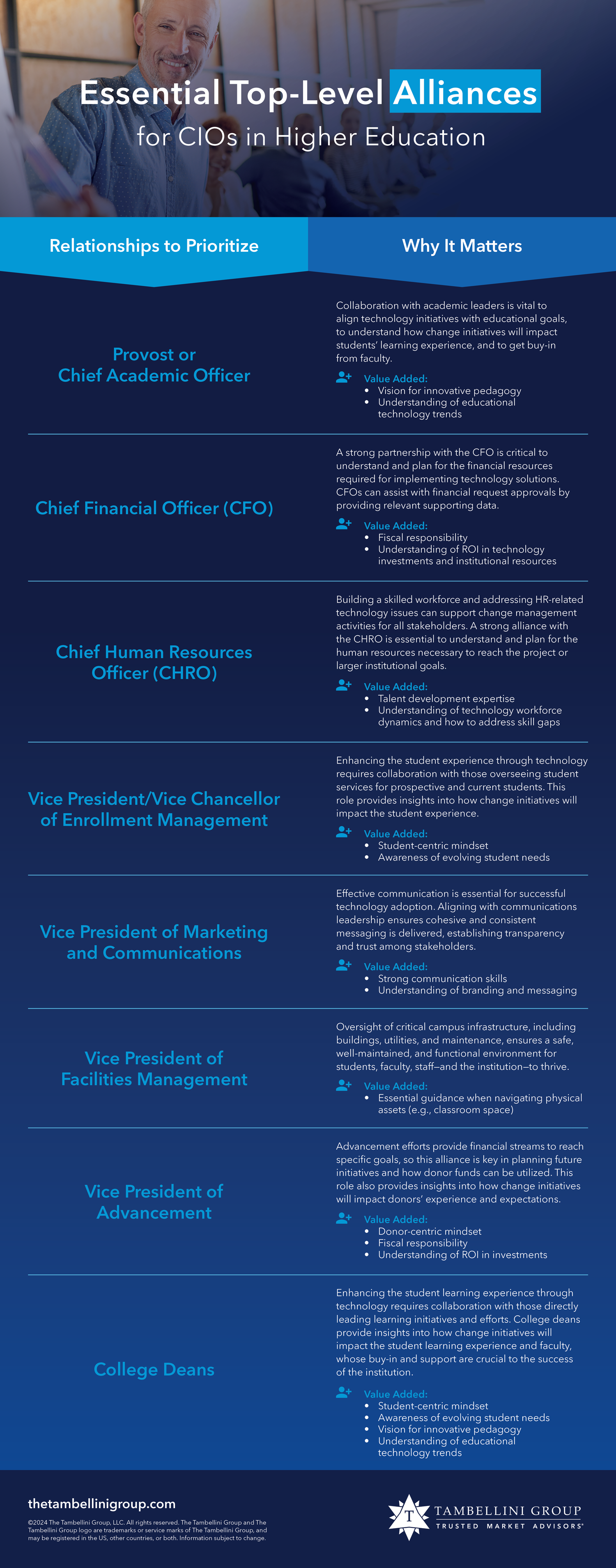Building Alliances That Drive Change in Higher Education
Former Analyst

Table of contents
Building partnerships and alliances that drive strategic change at colleges and universities is a crucial aspect of effective leadership, especially for a CIO leading innovation and change on campus. So, what alliances should CIOs prioritize to support and lead successful change initiatives at their institution?
The list below outlines pivotal partnerships that require CIOs to engage and collaborate with leaders, departments, and stakeholders across campus for optimal project and institutional success.
12 Questions to Answer Before Building Campus Alliances
Before building alliances, a CIO must first be clear on the specifics of the initiatives and goals, and how those align with institutional outcomes. A CIO leading transformation and innovation should be prepared to answer the following questions before reaching out to establish new or build upon existing alliances:
Strategic Alignment:
- How does the proposed initiative align with the institution’s overall strategic goals and mission?
Stakeholder Involvement:
- How will key stakeholders, including faculty, staff, and students, be impacted by the proposed changes?
- How will they be involved in the planning and implementation process?
Skills and Culture:
- What types of skills will be required from stakeholders impacted by the change?
- Will a culture shift be required to establish a mindset that will adopt the changes?
- How will the institution address skill gaps and resistance?
Budget and Resources:
- What are the estimated costs, and how will the initiative be funded?
- What resources, both financial and human, are required?
Timeline:
- What is the expected timeline for implementation?
- How will it be phased to minimize disruption?
Risk Management:
- What potential risks and challenges are anticipated?
- What strategies are in place to mitigate them?
Measurable Outcomes:
- How will success be measured?
- What key performance indicators (KPIs) will be used to assess the impact of the initiative?
Impact on Academics:
- What is the initiative’s potential impact on teaching, learning, and academic outcomes?
Being well prepared to address these questions can strengthen the CIO’s position when seeking alliances and support for transformation initiatives.
Powerful Traits for Effective Change Allies
Below are critical qualities that a leader should possess to foster and support change across campus. Alliances between individuals with these and other positive qualities will support a change journey that stakeholders will follow.
- Visionary thinking
- Collaborative mindset
- Belief in the initiative and outcomes
- Adaptability
- Data-driven decision making
- Excellent communication skills
- Acts as a role model
- Change management experience and expertise
- Stakeholder perspective and understanding
- Strategic planning acumen and perspective
- Growth and innovation mindset
- Inspires and motivates
- Demonstrates integrity and transparency in decision making
In seeking a partner to support change initiatives, these qualities collectively contribute to a dynamic and effective collaboration that drives positive transformation within the college or university.
Essential Top-Level Alliances for CIOs in Higher Education
Below is a list of essential top-level alliances higher education CIOs should invest in. These relationships are in addition to the stakeholders impacted directly by the change initiative.
(Note: Leadership titles vary by institution, e.g., vice president of human resources and organization development versus chief human resource officer. We understand these nuances and have included generally assumed titles below.)

Expanding alliances beyond the traditional top-level positions is crucial for comprehensive technology integration across campus. In addition to the leaders highlighted above, CIOs should also collaborate with the following roles to expand influence across the campus:
- Enrollment management leaders (e.g., Admissions and Financial Aid Directors)
- Research and grant officers or PI’s
- Academic advising leadership
- Library services director
- Career services director
- Student representatives
- IT security officer
- Auxiliary department heads (e.g., Housing, Dining)
- Health and wellness services director
- Staff and faculty council leaders
By forging alliances with the leaders identified above, CIOs can ensure that technology initiatives align with the diverse needs and goals of various campus departments. This comprehensive approach enhances the overall effectiveness of technology integration, promoting a seamless and interconnected campus experience for students, faculty, and staff.
Conclusion
Change initiatives should not be siloed efforts, but holistic and inclusive initiatives that foster a culture of innovation and growth across the institution through strategic alliances for success.
CIOs in higher education must actively cultivate alliances with key cabinet-level positions to drive meaningful change. Building strong relationships based on shared vision, collaboration, and strategic thinking is essential for successfully integrating technology into the fabric of colleges and universities. Through these alliances, institutions can embrace innovation, improve the student experience, and remain competitive in the ever-evolving higher education landscape.
Need help managing change on your campus? Explore Tambellini Group’s change management services.
You Might Also Like
Categories
Share Article:

Other Posts From this Author:
© Copyright 2025, The Tambellini Group. All Rights Reserved.